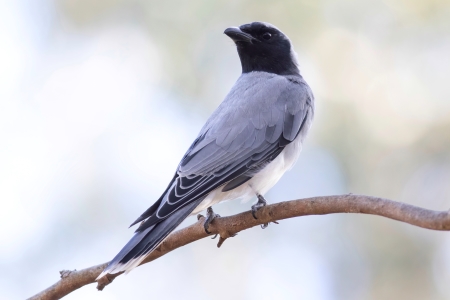Bird of the month: Black-faced Cuckoo-shrike
05 Aug 2022
PRODUCTION ADVICE & NRM NEWS - AUGUST 2022 - ENVIRONMENT
By Shanna Rogers, Senior Land Services Officer
P: 02 6051 2241 | M: 0457 733 261 | E: shanna.rogers@lls.nsw.gov.au

The August 2022 Woodland Bird of the Month is the Black-faced Cuckoo-shrike (Coracina novaehollandiae)
Black-faced Cuckoo-shrikes are a common sight in almost any wooded area across the Murray region.
The first part of the common name refers to the black face and throat of the bird. However, Cuckoo-shrikes are neither cuckoos nor shrikes! But they are so called because their feathers have similar patterns to cuckoos, and the beak shape resembles that of shrikes.
Coracinos is Greek for raven-like. Novaehollandiae means New Holland, an early name for Australia.
Black-faced Cuckoo-shrikes have a distinctive, undulating flight pattern, where they gain height by flapping their wings, then folding the wings back to glide forward and down, before flying back up and repeating the flight pattern. They also habitually shuffle their wings, alternately up and down, whenever they land. This practice gave rise to the name "Shufflewing", another common name for this species.
Their diet consists of insects, insect larvae, caterpillars, and other invertebrates (earthworms, millipedes, snails, spiders). In addition to insects, some fruits and seeds are also eaten.
The call most often heard is a soft churring, often described as a warbling 'creearck'.
The breeding season is chiefly from August to February each year. Both partners build the tiny nest. The fledglings leave the nest about three weeks after hatching. They look like adults, except the black facial mask is reduced to an eye stripe.
Outside the breeding season, they like to flock in groups of up to a hundred birds. Some may be partially migratory or may remain in the same territory. The lack of significant differences between regional populations in Australia makes it difficult to determine where populations move in winter.
Clockwise from top left 📸 thanks to:
- Black-faced Cuckoo-shrike (C)William Betts 2017 birdlifephotography.org.au
- Black-faced Cuckoo-shrike (C)Doug Wilson 2022 birdlifephotography.org.au
- Black-faced Cuckoo-shrike (C)Michael Hamel-Green 2021 birdlifephotography.org.au
- Black-faced Cuckoo-shrike (C)Simon Pelling 2021 birdlifephotography.org.au
Photo below: Black-faced Cuckoo-shrike (C)Rob Solic 2021 birdlifephotography.org.au
